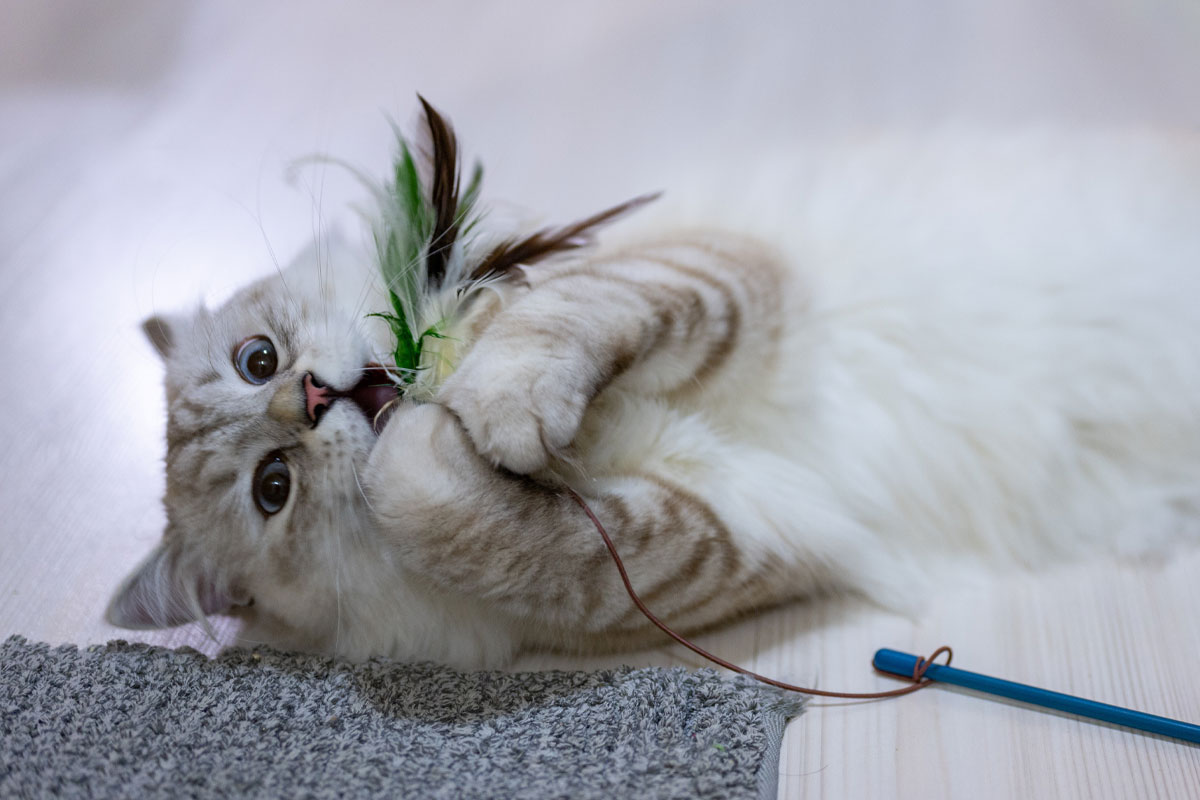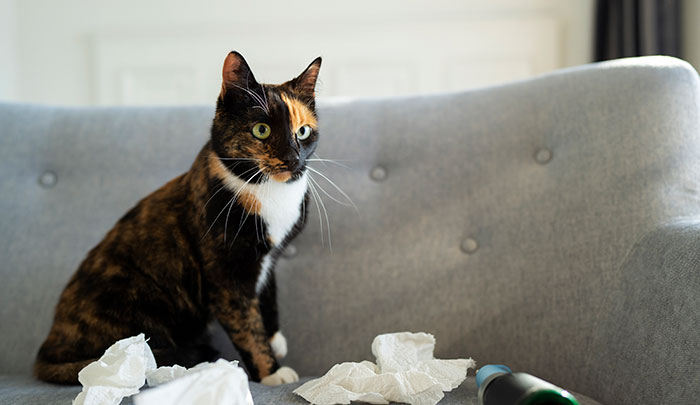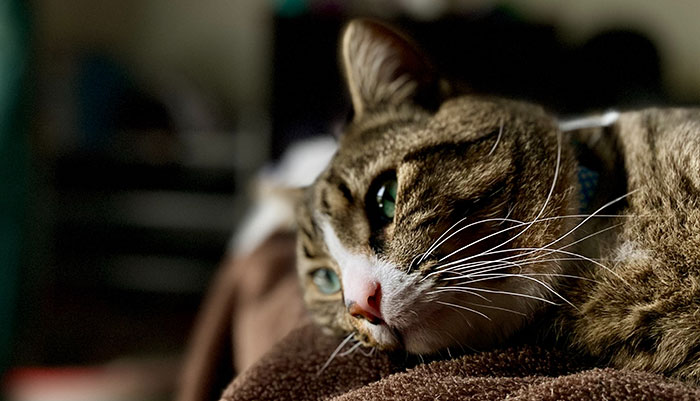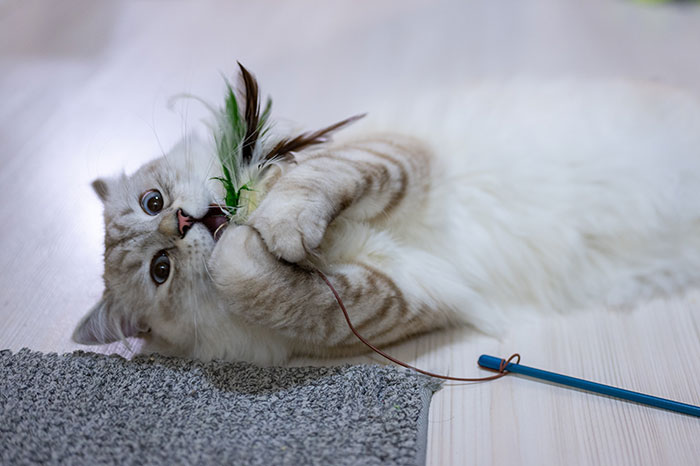Cats naturally explore their surroundings, often showing curiosity towards various objects, including plastic, to their owner’s horror. This behavior may lead them to chew on said plastic, which can concern pet parents.
Experts in the veterinary field have encountered numerous cases of cats exhibiting a propensity to chew and even consume plastic, prompting the need for a deeper understanding of this behavior and its potential risks.
- Cats may chew on plastic due to its intriguing sound and texture.
- Ingesting plastic poses serious health risks to cats.
- Symptoms of plastic ingestion include vomiting and appetite loss.
- Pet-safe chew toys can deter cats from chewing on plastic.
- Swift vet care is crucial if plastic ingestion is suspected.
Cats can be peculiar animals regarding behavior, leaving us with the burning question: why do they like to snack on plastic?
The information provided herein is for informational purposes only. Please refer to our disclaimer for more details..
- Why Do Cats Have a Desire to Chew on Plastic?
- What Are the Dangers of Cats Ingesting Plastic?
- Prevent Your Cat from Eating Plastic by Taking Precautions
- When Should Pet Owners Seek Veterinary Assistance for a Cat’s Plastic Ingestion?
- What Are Safe and Suitable Alternatives for Cats to Chew and Play With?
Why Do Cats Have a Desire to Chew on Plastic?
Cats are known for their curious and playful nature, frequently engaging in activities that involve pawing, chasing, and even chewing on objects within their environment. This innate behavior extends to the fascination with plastic items, including plastic bags, milk jug rings, and cords.
There can be various reasons why cats are drawn to chewing plastic. The crunching sound of a plastic bag or the rustling of a plastic object can appeal to their sensory perception, often piquing their curiosity.
Additionally, the texture of plastic may offer a different tactile experience for felines, leading them to explore and chew on such items.
While it may be challenging to eliminate their desire to chew on plastic completely, pet parents can take proactive measures such as keeping plastic items out of the cat’s reach, introducing safe and durable chew toys as alternatives, and ensuring a feline-friendly environment that alleviates the need for inappropriate chewing behavior.
What Are the Dangers of Cats Ingesting Plastic?
Cats ingesting plastic can pose serious health risks. The plastic material can cause obstruction in the digestive tract, leading to complications and potential blockages.
Additionally, certain plastics may contain toxic substances that can harm the feline’s internal organs upon ingestion, creating an urgent need for proper intervention and care.
It is essential for pet parents to be vigilant and observant of any signs indicating that their cat may have ingested plastic. Common symptoms include vomiting, lack of appetite, abdominal discomfort, and changes in litter box habits. If any of these signs are observed, immediate action should be taken to address the situation.
Image credits: Tim King
If a pet parent suspects their cat has ingested plastic, it is crucial to seek veterinary assistance immediately. Delaying professional care can exacerbate the risks and complications associated with plastic ingestion, potentially endangering their well-being.
In some cases, the veterinarian may need to perform diagnostic tests such as X-rays or ultrasounds to determine the location and severity of the obstruction. Treatment may involve medical management to help the cat pass the plastic material, or in more severe cases, and surgical intervention may be necessary to remove the blockage.
Prevention is critical in keeping cats safe from plastic ingestion. Pet parents should be mindful of the storage and disposal of plastic items in their homes, keeping them out of reach of curious felines. Using alternative, pet-safe materials for food and water bowls, toys, and litter boxes can also reduce the risk of plastic ingestion.
Additionally, providing enriching and stimulating environments for cats can help prevent them from becoming bored and seeking out non-food items to ingest. Regularly monitoring and interacting with cats can also help identify any abnormal behavior or signs of distress that may indicate potential plastic ingestion or other hazards. Anything that poses as a substance that could be ingested by your cat needs to be placed in another cat-free space.
Awareness of the risks, symptoms, and preventive measures related to cats ingesting plastic can help pet parents ensure their feline companions stay safe and healthy. Swift action and proper veterinary care are essential in addressing any cases of plastic ingestion to minimize the potential health complications for cats.
Prevent Your Cat from Eating Plastic by Taking Precautions
Providing safe and suitable alternatives to plastic, such as catnip-infused toys, puzzle feeders, and non-hazardous chew objects, can redirect their attention away from plastic items and toward more appropriate sources of stimulation and play.
Using deterrent sprays, creating physical barriers, and incorporating interactive play sessions can help discourage a cat from engaging in plastic chewing behavior. Consistent training and positive reinforcement techniques also play a significant role in guiding cats toward healthier chewing habits.
Seeking guidance from a veterinarian can provide valuable insight into preventing plastic ingestion. Veterinary professionals can offer personalized recommendations and interventions tailored to individual cats’ specific needs and behaviors, fostering a safer environment for feline companions.
When Should Pet Owners Seek Veterinary Assistance for a Cat’s Plastic Ingestion?
Pet owners should proactively identify when their pet’s plastic chewing behavior becomes a cause for concern. Any observed changes in behavior, signs of distress, or suspicion of plastic ingestion should prompt immediate attention and prompt veterinary evaluation.
Observing signs such as gagging, retching, or attempting to vomit without producing any results, as well as unusual bowel movements can indicate that a cat may have ingested plastic or other non-food items, necessitating swift medical intervention.
When a cat’s plastic ingestion is suspected, pet owners should not hesitate to visit their vet. Professional assessment and appropriate diagnostic measures can determine the extent of plastic ingestion and facilitate timely treatment, mitigating potential complications and ensuring their well-being.
What Are Safe and Suitable Alternatives for Cats to Chew and Play With?
Introducing a variety of cat-friendly chew toys, such as rubber balls, straw-based items, and interactive puzzle feeders, offers cats safe alternatives for chewing and play, enhancing their mental and physical well-being while minimizing the risk of ingesting harmful substances.
Image credits: Piotr Musioł
Establishing a cat-friendly environment involves removing potential hazards, providing enriching toys and structures, engaging in interactive playtime, and fostering a positive and stimulating atmosphere that encourages healthy chewing behavior and prevents cats from seeking non-food items like plastic.
Opting for durable and non-toxic materials when selecting toys and accessories for feline companions ensures their safety and well-being. Items such as durable rubber toys, cordless straw-like options, and interactive, treat-dispensing puzzles offer long-lasting enjoyment without the risks associated with plastic ingestion. Be sure to avoid any toys made of plastic materials as you encourage your cat to avoid similar things.
Interactive puzzle feeders, for example, offer mental and physical stimulation as cats have to work for their food, simulating natural hunting behaviors. This provides a fun and engaging activity for cats and helps prevent boredom and alleviate stress.
Rubber balls and straw-based items provide a safe outlet for chewing and play, satisfying the natural instinct to chew while minimizing the risk of ingesting harmful materials. These toys also offer an opportunity for interactive playtime, promoting bonding between cats and their human companions.
Incorporating a variety of textures and shapes in cat-friendly chew toys can help prevent boredom and keep cats engaged. Providing a range of options allows cats to satisfy their natural chewing and play instincts in a safe and stimulating way.
Overall, offering a selection of cat-friendly chew toys and play options can significantly enhance a cat’s overall well-being while reducing the risk of ingesting harmful substances. Owners can ensure their feline companions lead happy and healthy lives by creating a stimulating and safe environment for cats.

 Image credits:
Image credits: 




12
0